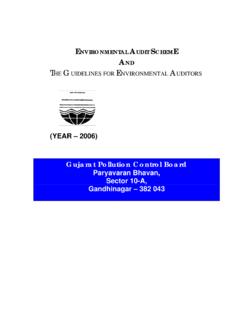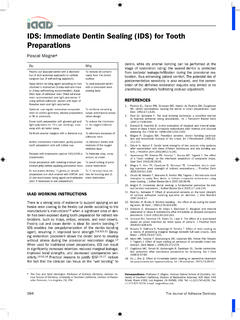Transcription of Zero Liquid Discharge (ZLD) Concept, Evolution and ...
1 Zero Liquid Discharge (ZLD)ConceptEvolution and technology OptionsConcept, Evolution and technology OptionsViatcheslav FregerWolfson Department of Chemical Engineering Technion Israel Institute of technology , Haifa, Israel ZLi idDi h WkhG dhiJ27282014 Zero Liquid Discharge Workshop, Gandhinagar, January 27 28, 20141 ZLD Feb 2014 Outline Historyandmotivation History and motivation Conventional ZLD Hybrid ZLD EiZLDdZLDlt ti Emerging ZLD and near ZLD alternatives OutlookZLD Feb 2014 2 Some History ZLD sector was apparently born in 1970s in USA, driven by the regulator Tight federal regulations on salt Discharge to surface waters introduced, especially.
2 Due to salinity problems in the Colorado River Regulations were mainly concerned with power plant discharges from cooling tower blowdowns and scrubbers (in the wake of previously introduced regulations on flu gas discharges) Clean Water Act 1974, revised 1977, 1982 First ZLDs installed were 500 2,000 GPM units based on evaporation/crystallization Regulations are expected to keep tightening: new EPA s guidelines (ELG) expected in 2017 and 2022 on various fdh(hb)Freger ZLD Feb 2014 3types of discharges (many have to be ZLD)Sources: GWI Report, 2009; G. Maller/URS, 2013 Current Drivers and Limitations Presently, the major driver for using ZLD are Environmental regulation on Discharge of specific solutes (salt, toxic elementsnitrate nitriteetc);elements, nitratenitrite etc); Water scarcity/water stress growing world wide along with still negligible rate of waste water recycling; Economics: recycled water becomes more affordable as the water supply from conventional sources becomes more expensive.
3 Giilibiliddidf Growing social responsibility and education towards awareness of environmental issues While ZLD cost is high in most cases, it might be a more economic solution g,gwhen waste needs to be transported in large volumes over long distances Still ZLD has drawbacks, probably, the most significant are Very high cost (both CAPEX and OPEX) Custom design on case to case basisFreger ZLD Feb 2014 4 Difficulties to deal with complex streams ( , petrochemical)Current and Potential Markets for ZLD Treatment and recycling of industrial waste effluentsPowerPetroleumandpetrochemical Power Synthetic fuels Primarymetalsprocessing Petroleum and petrochemical Oil refining SteamAssistedGravityDrainagePrimary metals processing Microelectronics ChemicalSteam Assisted Gravity Drainage (SAGD) heavy oil recovery Cogeneration Pulp and paper Coal mining Fertilizer Solid waste (leachate and secondarysewageeffluent) Battery manufacturing PVC manufacturingUraniumminingsecondary sewage effluent)
4 Coal liquefaction Ethanol production Uranium mining Tertiary treatment of municipal waste effluents InlanddesalinationFreger ZLD Feb 2014 5 Inland Thermal ZLD technology The conventional ZLD is based on evaporation and crystallizationoperationscrystallization operations Evaporation (MVC or live steam) usually aims at >90% water recovery y crystallization may achieve 100% recovery solidscanbefurtherdewateredonafilter press solids can be further dewatered on a filterpress for landfill Latent heat of evaporation is partly recovered (especially, for MVC) Operational and capital costs are still very high dthi hti(2040kWh/3due to high energy consumption (20 40 kWh/m3vs.))
5 2 3 kWh/m3in desalination), use of chemicals and expensive corrosion resistant ZLD Feb 2014 6 MVC Evaporation (Falling Film)Potential issues: -Tboilelevation (for MVC)Prior removal of SS and Ca requiredFreger ZLD Feb 2014 7-Prior removal of SS and Ca required-Mg(OH)2precipitation (scaling and corrosion)-High MgCl2and CaCl2solubility CrystallizationAtmospheric Crystallization with Softening Pretreatment(Tboilmay be too high for MgCl2and CaCl2)Vacuum crystallization(lower Tboil, higher salt concentration)Freger ZLD Feb 2014 8K. Jenkins et al/CH2M Hill, WaterWorld, 2013 Hybrid ZLD Technologies Due to the high cost there is a strong motivation to employ more energy saving process to minimize the MVC/Crystallization share.
6 (Compare with costs of desalination technologies: RO << ED << Thermal.) Reverse Osmosis* (RO) rejects salt, passes water, 2 4 kWh/m3 Nanofiltration* (NF) similar to RO, but passes some salt Electrodialysis* (ED) or ED reversal (EDR) removes ion, costs it dittROdMVCintermediate to RO and MVC Natural Evaporation slow, large footprints Another possible motivation is presence of organics, volatiles, colloids etc., which complicates the treatment and water reuse. Available solutions: Conventionalbioremediation Conventional bioremediation MBR/UF pretreatment Freger ZLD Feb 2014 9*RO, NF and ED will be covered in detail on 2nddayZLD Combined with RO RO is presently the best and most energy saving available technology for desalting.
7 The purpose is then to use RO to recover as much water as possible before MVC. TheZLDcostdropsasROrecoveryincreasesThe ZLD cost drops as RO recovery increases. The recovery in RO is however limited by 3 main factors OsmoticpressurebecomestoohighforTDS~8000 0ppm Osmotic pressure becomes too high for TDS 80,000 ppm Scaling by sparingly soluble salts (Ca, Mg, SO4, PO4, silica), maybe alleviated to some degree using anti scalants Fouling(byorganicscolloidsbiofilmsetc ) Fouling (by organics, colloids, biofilms etc.) - 150 Cost of Brine Concentration for / m3produBC - - 50 Freger ZLD Feb 2014 10708090100% RecoveryGlueckstern, Proc. 6th IDS, 2003RO Limitations on RecoveryBrine Conc140160180, atmConcScaling Onset 80100120140pressure20406080 Exit concRO Recovery0205060708090100EO%Scaling Potential vs.
8 RecoveryRO Recovery, %Brine Osmotic Pressure vs. RecoveryJv= Lp( P LSI= SP/SPc~ Cn, n ~ 2-5 Freger ZLD Feb 2014 11 Increasing RO Recovery: 2 Stage RO/NF A simple 2 stage (different membranes & pressures used at each stage) Interstagesoftening/precipitation (more chemicals used)Rahardianto, et al., JMS 2007; EST, 2008; Des. 2010, Sancioloetal.,Chemosphere, (more chemicals used)Sancioloet al., Chemosphere, 85%3000 mg/LProductYsec= 67%18100 mg/L005QA/S19440 Qf54000 mg/LBrine TreatmentFreger ZLD Feb 2014 12FB CrystallizerHigh Efficiency RO (HERO) Process High Silica Water Cooling Tower BlowdownBlowdown Tertiary Treated Effluent (Sewage) High/TOC Biologically ByremovingCaandcarbonatehardnessROcanrun atggyActive Water By removing Ca and carbonate hardness RO can run atpH > HighpHcreatesa cleaningenvironment =>lowfouling High pH creates a cleaning environment > low fouling Silica solubility very high, hardness removed => low scaling Saltrejectionandfluxareincreased Salt rejection and flux are increased Recovery >90% Howeverhighchemicalcostsadd~$013/m3overa llproductFreger ZLD Feb 2014 13 However, high chemical costs add $ productSource: FEMP Bulletin, DOE/EE 0294.)
9 Combined with ED ED is not limited by osmotic pressure and thus it can achieve a much higher hhROblh Typically, ED desalting cost is higher than RO but lower than MVC/crystallization. The optimal placement of ED is then betweenROandevaporationbetween RO and ZLD Feb 2014 14 Increasing ED recovery for ZLD As in RO, precipitation of sparingly soluble salts in the brine limits recovery. Proposed solutions includeOffkii i(dd) Off stack precipitation (seeded) EDM in place of regular EDon (%)3540m Oversaturatio202530 Time (Hrs)02468 Gypsum1015 Time (Hrs)Onset of precipitationFreger ZLD Feb 2014 15 Oseopecpoplace crystallizer in brine loopR. Bond et al, 2011, Florida Water Res J; J.
10 Gilron, Wetsus, 2013. ED MetathesisFormation of sparinglyFormation of sparingly soluble salts prevented using a stack of 4-compartment units Freger ZLD Feb 2014 16R. Bond et al, 2011, Florida Water Res J; T. Davis, USBR Rpt. 135. RO+EDM+Off Stack Precipitation ZLD ProcessT. Davis, USBR Rpt. 135. Freger ZLD Feb 2014 17 Biological (Pre )Treatment()dldl Removes TOC (most organics) as CO2and sludge, may leave some recalcitrant organicss MBR/UF is significantly more expensive, but offers a smaller footprint /gyp,pand a more robust processTirupurProjectTirupurProject Textile Effluent, 54 MLD, 2007S. Prakash, GWI, Barcelona, 2007 Ambur VaniyambadiTannery Effluent7 MLD, 2007 Freger ZLD Feb 2014 18 Emerging and State of the Art ZLD Solutions Several alternative technologies or hybrids are in use or being idfZLDexamined for ZLD.






